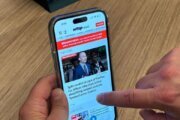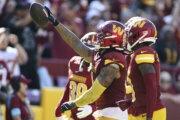For many Black student-athletes, choosing a historically Black college or university has appeal.
Many HBCUs, for example, have fewer students enrolled compared to bigger predominantly white institutions, or PWIs. This allows student-athletes to take advantage of smaller class sizes and more interaction with their professors. Black students, typically the vast majority at HBCUs, also often say they feel a stronger cultural connection at these schools.
However, HBCUs face challenges when it comes to media exposure for their student-athletes. Some HBCUs also don’t have the same level of facilities, compared to PWIs, to prepare athletes for top competition.
Experts say student-athletes should consider several things when thinking about attending an HBCU and whether they’ll be able to thrive there as athletes.
Real and Perceived Barriers
While some HBCUs struggle with their level of available financial resources, not all of them do. It has been difficult to break the chain regarding a long-standing perception of HBCUs as less financially viable, but there has been a change in recent years, says Akilah Carter-Francique, dean of the school of education, health and human services at Benedict College, an HBCU in South Carolina.
The 2020 death of George Floyd in police custody in Minnesota led to hundreds of protests across the U.S., raising the national dialogue on race and sparking renewed interest in HBCUs among Black prospective college students. Several HBCUs also reported increased enrollment following the protests. For example, enrollment at the all-men Morehouse College in Georgia increased from 2,300 in 2018 to 3,200 after the 2020 protests.
“We’re seeing it more on the forefront to curb the culture, or that negative deficit swath, for our HBCUs. And we’re seeing athletes make those decisions to go to an HBCU,” says Carter-Francique, who co-edited a 2015 collection of scholarly articles for a book titled “The Athletic Experience at Historically Black Colleges and Universities: Past, Present, and Persistence.”
[Read: A Guide to HBCUs. ]
At nearly $109 million in May 2023, Florida A&M University‘s endowment is one of the largest among HBCUs. That amount for FAMU, an NCAA Division I school, is far below the average endowment of $1.2 billion among the 688 institutions that completed the National Association of Black Colleges and Universities 2023 fiscal year survey conducted by the National Association of College and University Business Officers.
FAMU benefits from being the only HBCU in Florida’s public university system, says Willie Simmons, a former head football coach there and currently an assistant football coach at Duke University in North Carolina.
“A lot of the resources go there as opposed to being in (a) state where there are multiple public HBCUs in the system,” Simmons says. “So the money has been divided a little bit more evenly.”
Another NCAA Division I HBCU similarly positioned is Prairie View A&M University, the only HBCU in the 11-school Texas A&M University system. Prairie View, along with the other schools in the Texas A&M and the University of Texas systems, benefits from the billions of annual dollars in state oil and gas revenue.
Simmons adds that other private HBCUs — like Howard University in Washington, D.C., and Hampton University in Virginia — also benefit from having some of the largest endowments and giving bases among HBCUs. Howard is expected to become, in 2024, the first HBCU with an endowment reaching $1 billion.
Simmons says more institutional money can enhance the student-athlete experience in the classroom by allowing different initiatives like financial literacy and providing more academic tutoring programs. Both would be beneficial, given the smaller size of academic and compliance departments at HBCUs compared to bigger Group of Five schools, he says.
In addition, more money could also benefit athletic department budgets, since most are self-sufficient and rely on money that they can bring in themselves, like from ticket sales and guaranteed games.
“That’s where a lot of them are lacking, ” Simmons says regarding funding for HBCU athletic departments.
Opportunities Only at HBCUs
Student-athletes who decide to attend an HBCU can contribute to a legacy of leaders, athletes, coaches and other pioneers who made an impact.
For example, in 1967 in North Carolina, Winston-Salem State University head basketball coach Clarence “Big House” Gaines became the first to lead an HBCU to an NCAA Division II tournament championship and was a pioneer in Black integration of intercollegiate athletics.
[READ: Name, Image, Likeness: What College Athletes Should Know About NCAA Rules.]
Meanwhile, another Black HBCU coach, C. Vivian Stringer, led Cheyney University of Pennsylvania to the school’s first NCAA women’s basketball championship game in 1982 — the first NCAA women’s basketball Final Four — and she was the first coach in the history of men’s and women’s college basketball to take three different colleges to the Final Four.
“There are individuals that came and were birthed and were nurtured out of our HBCUs that have really created the standard across all colleges and universities,” Carter-Francique says, “but also in various fields when we talk about careers or academics.”
HBCU student-athletes often can also create more of an identity on campus, Simmons says.
“At historically Black institutions, the majority of students look like you and come from similar backgrounds,” Simmons says. “So the ability to kind of find yourself outside of the realm of just being an athlete is sometimes a better environment than a PWI.”
There’s “an understanding of the history and legacy of marginalization, and in many respects, that is rooted in that systemic racism,” Carter-Francique says. “I think we in those spaces really work to nurture those young people. Yes, based on race and ethnicity, but also those when we talk about socioeconomic status, gender or religion.”
Media Exposure
Media companies that highlight legacy games like the annual Bayou Classic raise public awareness of HBCUs, creating more opportunities and increasing exposure for student-athletes, Carter-Francique notes.
Often in revenue-generating sports like football and basketball, HBCUs play bigger Division I schools, essentially guaranteeing these HBCUs money for their athletic programs, travel scholarships and other expenses. But the ultimate result of these matchups can be a negative impact on the perception of HBCUs among potential student-athletes.
[Playing a Sport in Each NCAA Division: What to Know]
HBCUs getting beaten badly by larger Division I programs can reinforce negative perceptions of attending an HBCU as a student-athlete, Carter-Francique says. However, highlighting HBCUs in competition against each other would better display the skills of those athletes, she says.
“If we were to highlight an HBCU classic and see the phenomenal skill at HBCUs, then we’re comparing apples to apples,” Carter-Francique adds.
In spring 2023, CBS Sports donated $100,000 to rising juniors attending an accredited United Negro College Fund member institution or another qualifying HBCU. More actions like this can highlight the connection between HBCU athletic legacy and financial support, Carter-Francique says.
Tips for Thriving
As when choosing any college, it’s important for student-athletes to do thorough research when considering if an HBCU is the right fit for them, experts say. Making a checklist of what will make an institution a good fit could help with the decision-making process, Carter-Francique says.
Student-athletes should strive to translate the competitive spirit exhibited in their sport to career skills development, advises Johnathan Holifield, a former executive director of the White House Initiative on Historically Black Colleges and Universities who was also a collegiate and professional athlete.
“I have observed from my era of playing sports that many are not able to convert that spirit that was displayed on the field, into the same spirit of showing up, working hard and competing at the highest level in their careers,” says Holifield, who had a brief stint in the NFL after playing at West Virginia University.
Of the one-half million student-athletes participating in college sports that have professional leagues, less than 2% make it to the pros, the NCAA reports. That’s why it’s important that student-athletes not only pick the best school for them to be successful on the field, but also a school that helps them develop skills in their discipline needed to make them marketable, experts say.
That can mean participating in clubs, organizations and other activities that help student-athletes develop these skills, Holifield says.
Holifield adds that with the emergence of name, image and likeness rules, colleges don’t necessarily have an obligation to maintain supportive relationships with student-athletes who leave their program, which makes nurturing marketable, in-demand skills while in school more critical.
“Now if the institution chooses to keep the door of relationship and support open, that’s one thing,” Holifield says. “But when you’re ostensibly paying people to perform, it’s a job, and just like your former or past employer has no obligation to support you in your future endeavors, I think less and less institutions will take on that responsibility.”
More from U.S. News
College Scholarships for Lesser-Known Sports
How to Juggle a Premed Focus and College Sports
Sports Betting on College Campuses: What to Know
How to Thrive as an HBCU Student-Athlete originally appeared on usnews.com







